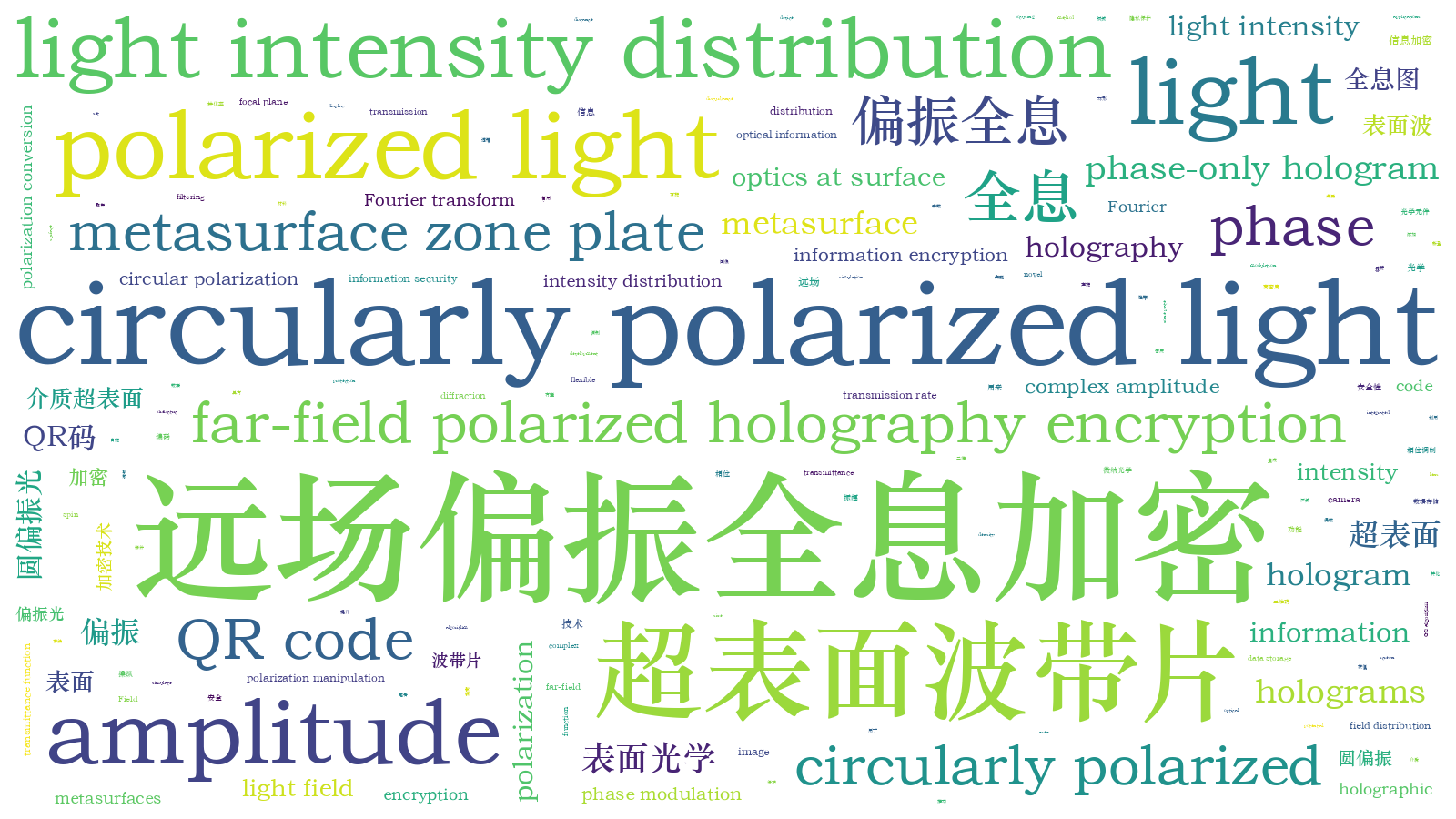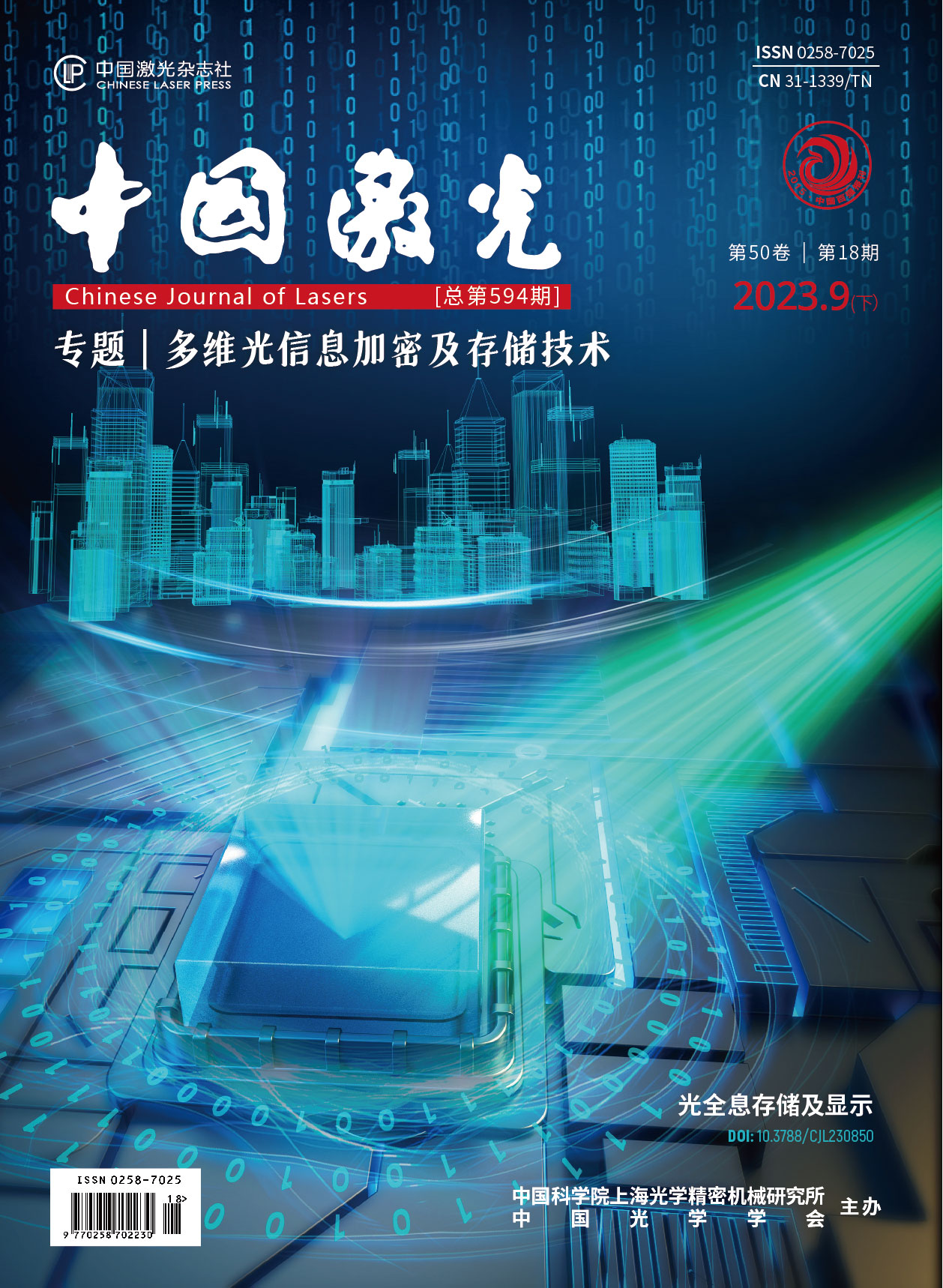基于超表面波带片的远场偏振全息加密  下载: 620次特邀研究论文【增强内容出版】
下载: 620次特邀研究论文【增强内容出版】
Metasurfaces have flexible polarization manipulation functions; however, a lens must be added to obtain the desired far-field-polarized holographic images. This study demonstrates a novel far-field polarization holographic encryption method using flexible polarization manipulation and the focusing capabilities of metasurface zone plates. Two spin-multiplexed metasurface zone plates are integrated into a single metasurface device, where the amplitude (right-handed circular polarization conversion rate) of the metasurface is used to encode the odd and even annular regions of the zone plates, and its phase modulation is utilized to encode two holograms of the transmitted right and left circularly polarized light. Additionally, QR codes and amplitude-only/phase-only holograms are used to hide encrypted information and improve data security. The proposed encryption technology is expected to enhance data security and privacy protection and promote the development of optical information encryption and high-density data storage.
The metasurface consisted of odd and even zones of a metasurface zone plate. When left-handed circularly polarized light is incident on the surface, the odd and even zones transform the light into right- and left-handed circularly polarized light, respectively. The polarization conversion efficiencies are 100% and 0% for the odd and even zones, respectively. For the odd zones, the amplitude of the transformed right-handed circularly polarized light is equal to one. For the even zones, the amplitude of the transformed left-handed circularly polarized light is also one. Therefore, the amplitudes of the odd and even zones can be considered amplitude-only odd and even Fresnel zone plates, respectively. In addition, the phases of the odd and even zones were designed as holograms corresponding to right- and left-handed circularly polarized light, respectively (Fig. 2). Thus, the two types of holograms have their respective holographic images in the same focal plane of the amplitude-only odd and even Fresnel zone plates. However, because the images overlapped, the desired encrypted holographic images could not be identified. Therefore, filtering out the right- or left-handed circular polarization can decrypt the corresponding encrypted holographic images.
We use a QR code-generating website to create QR codes that correspond to amplitude-only and phase-only holograms. We then apply the GS algorithm, based on the Fourier transform relationship, to generate either an amplitude-only or a phase-only hologram. Subsequently, the amplitude-only hologram and phase-only hologram undergo Fourier transform to produce an encrypted intensity profile and an encrypted intensity distribution, respectively (Fig. 3). The odd and even zones refer to the designed holograms corresponding to the output right- and left-handed circular polarization components, respectively. Although transmitted phases exist for the left and right circular-polarization components in the odd and even zones, respectively, the amplitudes of these phases are essentially zero and can be disregarded (Fig. 4). To simulate the diffraction light field distribution of actual metasurfaces, we match the phase and amplitude of a single pixel in the annular region in Figs. 4(c1) and (d1) and Figs. 4(c2) and (d2) to the transmitted phase and transmission rate of all corresponding positions of the metasurface using the phase and transmission rate databases of differently sized meta-atoms in Figs. 2(b)-(e). The complex amplitudes of the left- and right-circularly polarized light transformed by the metasurface are calculated using the transmitted phases and geometric phases in Figs. 4(e1) and (e2). Finally, the diffraction light field distribution at the focal plane is calculated using the x- and y-polarization components of the actual complex amplitude of the circularly polarized light and diffraction formula (3) and (4). Because the transmission rate and phase of the meta-atoms differ from the expected amplitude and phase, the center of the Fourier hologram focal plane may have a high-intensity bright spot, making it impossible to display the hologram image. To eliminate the disturbance of the bright spot in the hologram image of the transmitted left-circularly polarized light, we set all values in the central area of the actual light intensity distribution with a size of 16.5 μm×16.5 μm to 0, which is equivalent to physically blocking the central zero-order with an opaque square screen, thus obtaining the QR code image represented in Fig. 5. Figure 5 shows the simulation results representing the hologram image at a simulated distance of z=14.1 mm. The transmitted QR code intensity profile could not be recognized by the phone camera when the left-handed circularly polarized incident light is used. However, when the transmitted right-handed circularly polarized light is filtered out, the calculated QR code intensity profile can be identified using a phone camera. The decrypted information corresponds to the amplitude-only hologram, and we obtain the final decryption information by performing a Fourier transform on the amplitude-only hologram transmittance function. Moreover, by filtering out the transmitted left-circularly polarized light, the calculated QR code intensity profile can be identified using a phone camera. In this case, the decrypted information corresponds to a phase-only hologram, and we obtain the final decryption information using the Fourier transform of the phase-only hologram transmittance function (Fig. 5).
We introduce a novel approach for achieving far-field polarized holography encryption by integrating two types of metasurface zone plates into a single dielectric spin-multiplexed metasurface. Specifically, we utilized amplitude-only odd- and even-zone plates for their amplitudes and phase holograms of the transmitted right- and left-circularly polarized light for their phases. Our results demonstrate that encrypted information can only be decrypted when a single circularly polarized state is filtered. The use of QR codes and amplitude-only/phase-only holograms further improves information security. The proposed metasurface technology has potential applications in the fields of data storage and information encryption.
1 引言
超表面因能够任意调控波前而被广泛认为是传统光学元件的潜在替代品。可重构的超表面不仅能够满足光学系统设计对小型化器件的需求,还由于其超原子具有多种设计自由度和光场操纵自由度而在彩色打印[1-2]、光学加密[3]、超透镜[4-6]、全息术[7-11]和非线性光学[12-14]等领域具有广阔的应用前景。
光具有许多基本调控参量,如振幅、相位、偏振、频率、入射角、轨道角动量和自旋角动量等,其中的偏振是一个关键参量,可用于光学信息编码、数据存储和复用传输通信等。通过控制电磁波的偏振,超表面可以实现偏振复用和矢量超表面全息。超表面全息所需要的全息图通常通过传统的相位恢复算法来生成[15-17]。偏振全息可以通过正交或任意偏振来调节,包括线偏振、圆偏振、椭圆偏振和多通道偏振。偏振超表面全息自提出以来,已经取得了重大进展,包括基于马吕斯定律[18-19]、斯托克斯矢量[20-22]和多通道复用[23-25]的技术。值得注意的是,近些年远场偏振全息引起了研究人员的极大兴趣。超表面可以在实空间中生成二进制或灰度图像,同时在k空间中生成偏振全息图像[26]。另外,使用双相位方法制备的超表面可以在聚焦透镜的焦平面上产生全息图像,该图像具有设计的偏振状态和衍射级别[27]。但是,上述方法需要在光路中添加透镜。超表面波带片(meta-FZP)是一种新型的光学元件,具有许多出色的特性。利用介质超表面波带片取代菲涅耳波带片,能够同时调节光的振幅、相位和偏振,并且控制的偏振态能覆盖整个庞加莱球[28]。携带螺旋相位的偏振不敏感超表面波带片能够产生多个具有不同轨道角动量的涡旋光束[29]。此外,研究人员还报道了奇偶区由不同超原子组成的太赫兹超表面波带片可以实现从任意入射偏振态到固定偏振态的转换[30]。然而,基于超表面波带片的远场偏振全息还没有得到深入研究。
笔者提出了一种可实现远场偏振全息加密的自旋复用介质超表面,该超表面器件由两个振幅型奇偶超表面波带片构成。奇偶超表面波带片的相位分别对应于透射的右旋和左旋圆偏振光的相位全息图。加密的全息信息只有在单个圆偏振分量被过滤后才能解密。此外,笔者采用二维码(QR码)和振幅/相位型全息图来增强信息加密的安全性。QR码与转换的圆偏振态有关,最终加密的信息可以使用手机相机和傅里叶变换进行解密。这些技术提高了全息加密的安全性和可靠性。
2 设计与理论
二氧化钛椭圆柱单元的长轴为

图 2. 超表面波带片的调控机制。(a)超原子的俯视图和侧视图;在波长为633 nm的x线偏振入射光下,不同尺寸的超原子在x偏振方向的透过率分布图(b)和相位分布图(c);在波长为633 nm的y线偏振入射光下,不同尺寸的超原子在y偏振方向的透过率分布图(d)和相位分布图(e);在左旋圆偏振入射光下,超表面(a1)由奇数超表面波带片(a2)和偶数超表面波带片(a3)组成,其中,奇数超表面波带片的振幅和相位分别如图(a4)、(a5)所示,偶数超表面波带片振幅和相位分别如图(a6)、(a7)所示
Fig. 2. Modulation mechanism of metasurface zone plates. (a) The top and side views of the meta-atom; transmission (b) and phase (c) of the meta-atom with different sizes along x-polarization under the x-linearly polarized light with the wavelength of 633 nm; transmission (d) and phase (e) of the meta-atom with different sizes along y-polarization under the y-linearly polarized light; under the left-circularly polarized incident light, the metasurface (a1) consists of the odd metasurface zone plate (a2) and even metasurface zone plate (a3), where the amplitude and phase of the former were exhibited in Figs. (a4) and (a5) and those of the latter were exhibited in Figs. (a6) and (a7)
式中:J(θ)表示琼斯矩阵;ϕ1和ϕ2分别表示透射的右旋圆偏振
3 结果与讨论
透射的右旋和左旋圆偏振光的编码信息分别表示在

图 3. 透射圆偏振光的编码信息。(a1)(a2)QR码;(b1)QR产生的振幅型相位型全息图;(b2)QR产生的相位型全息图;(c1)振幅型全息图在远场模拟计算的加密强度图;(c2)相位型全息图在远场模拟计算的加密强度图
Fig. 3. Encoding information of transmitted circularly polarized light. (a1)(a2) QR codes; (b1) QR codes generated amplitude-only hologram; (b2) QR codes generated phase-only hologram; (c1) calculated encrypted intensity profile in the far field of the amplitude-only hologram; (c2) calculated encrypted intensity distribution in the far field of the phase-only hologram

图 4. 在左旋圆偏振光下,透射的右旋圆偏振光(a1)和左旋圆偏振光(b1)在奇数环形区域的全息相位,以及相对应的在x和y线偏振入射光下分别沿着x方向(c1)、y方向(d1)的传输相位及几何相位(e1)。透射的右旋圆偏振光(a2)和左旋圆偏振光(b2)在偶数环形区域的全息相位,以及相对应的在x和y线偏振入射光下分别沿着x方向(c2)、y方向(d2)的传输相位及几何相位(e2)
Fig. 4. Hologram phases on the odd annular zones of the transmitted right-handed (a1) and left-handed (b1) circularly polarized light under the left-handed circularly polarized light, and the corresponding output phase distributions along the x-direction (c1) and y-direction (d1) under the x- and y-linearly polarized lights, respectively. The corresponding geometric phase is shown in Fig. (e1). The hologram phase on the even zones of the transmitted right-handed (a2) and left-handed (b2) circularly polarized light under the left-handed circularly polarized light, and the corresponding output phase distributions along the x-direction (c2) and y-direction (d2) under the x-and y-linearly polarized lights, respectively. The corresponding geometric phase is shown in Fig. (e2)
任意轴向位置z处的矢量衍射场能通过
式中:
为了模拟实际超表面的衍射光场分布,用

图 5. 在左旋圆偏振光入射下,透射的混合圆偏振光(a)、右旋圆偏振光(b)和左旋圆偏振光(c)在设计距离z=14.1 mm处的仿真全息图像
Fig. 5. Simulated holographic images at the designed distance of z=14.1 mm for the transmitted hybrid circularly polarized light, right-handed circularly polarized light and left-handed circularly polarized light under the left-handed circularly polarized incident light, respectively
4 结论
笔者通过将两种类型的超表面波带片集成到单个自旋复用介质超表面中实现了远场偏振全息加密。具体来说,将振幅型奇偶环形区域作为超表面的振幅,将透射的右旋/左旋圆偏振光的相位全息图分别设计为奇数和偶数波带片的相位。研究结果表明,只有在滤出单个圆偏振状态时才能解密加密信息。使用QR码和振幅型/相位型全息图可以进一步提高信息的安全性。所提超表面在数据存储和信息加密方面具有潜在应用。
[1] Yoon G, Lee D, Nam K T, et al. Crypto-display in dual-mode metasurfaces by simultaneous control of phase and spectral responses[J]. ACS Nano, 2018, 12(7): 6421-6428.
[2] Jang J, Jeong H, Hu G W, et al. Tunable metasurfaces: Kerker-conditioned dynamic cryptographic nanoprints[J]. Advanced Optical Materials, 2019, 7(4): 1970016.
[3] Luo X H, Hu Y Q, Li X, et al. Integrated metasurfaces with microprints and helicity-multiplexed holograms for real-time optical encryption[J]. Advanced Optical Materials, 2020, 8(8): 1902020.
[4] Khorasaninejad M, Chen W T, Devlin R C, et al. Metalenses at visible wavelengths: diffraction-limited focusing and subwavelength resolution imaging[J]. Science, 2016, 352(6290): 1190-1194.
[5] Chen W T, Zhu A Y, Sanjeev V, et al. A broadband achromatic metalens for focusing and imaging in the visible[J]. Nature Nanotechnology, 2018, 13(3): 220-226.
[7] Huang L L, Chen X Z, Mühlenbernd H, et al. Three-dimensional optical holography using a plasmonic metasurface[J]. Nature Communications, 2013, 4: 2808.
[8] Zheng G X, Mühlenbernd H, Kenney M, et al. Metasurface holograms reaching 80% efficiency[J]. Nature Nanotechnology, 2015, 10(4): 308-312.
[12] Wang L, Kruk S, Koshelev K, et al. Nonlinear wavefront control with all-dielectric metasurfaces[J]. Nano Letters, 2018, 18(6): 3978-3984.
[13] Reineke B, Sain B, Zhao R Z, et al. Silicon metasurfaces for third harmonic geometric phase manipulation and multiplexed holography[J]. Nano Letters, 2019, 19(9): 6585-6591.
[14] Yang G H, Li Z X, Kang Q L, et al. Enhanced magnetic Lorentz force second harmonic generation originating from a double-resonances plasmonic metasurface[J]. Journal of Physics D: Applied Physics, 2021, 54(17): 175110.
[15] di Leonardo R, Ianni F, Ruocco G. Computer generation of optimal holograms for optical trap arrays[J]. Optics Express, 2007, 15(4): 1913-1922.
[16] Mu Y H, Zheng M Y, Qi J R, et al. A large field-of-view metasurface for complex-amplitude hologram breaking numerical aperture limitation[J]. Nanophotonics, 2020, 9(16): 4749-4759.
[18] Zang X F, Dong F L, Yue F Y, et al. Polarization encoded color image embedded in a dielectric metasurface[J]. Advanced Materials, 2018, 30(21): 1707499.
[19] Deng L G, Deng J A, Guan Z Q, et al. Malus-metasurface-assisted polarization multiplexing[J]. Light: Science & Applications, 2020, 9: 101.
[20] Ren H R, Shao W, Li Y, et al. Three-dimensional vectorial holography based on machine learning inverse design[J]. Science Advances, 2020, 6(16): eaaz4261.
[21] Deng Z L, Deng J H, Zhuang X, et al. Diatomic metasurface for vectorial holography[J]. Nano Letters, 2018, 18(5): 2885-2892.
[22] Bao Y J, Ni J C, Qiu C W. A minimalist single-layer metasurface for arbitrary and full control of vector vortex beams[J]. Advanced Materials, 2020, 32(6): 1905659.
[23] Lane S, Vagin S, Wang H, et al. Wide-gamut lasing from a single organic chromophore[J]. Light: Science & Applications, 2018, 7: 101.
[24] Yang H, He P, Ou K, et al. Angular momentum holography via a minimalist metasurface for optical nested encryption[J]. Light: Science & Applications, 2023, 12(1): 79.
[25] Zhou H Q, Sain B, Wang Y T, et al. Polarization-encrypted orbital angular momentum multiplexed metasurface holography[J]. ACS Nano, 2020, 14(5): 5553-5559.
[26] Zhao R Z, Xiao X F, Geng G Z, et al. Polarization and holography recording in real- and k-space based on dielectric metasurface[J]. Advanced Functional Materials, 2021, 31(27): 2100406.
[27] Zhao R Z, Li X, Geng G Z, et al. Encoding arbitrary phase profiles to 2D diffraction orders with controllable polarization states[J]. Nanophotonics, 2023, 12(1): 155-163.
[28] Yoon G, Jang J, Mun J, et al. Metasurface zone plate for light manipulation in vectorial regime[J]. Communications Physics, 2019, 2: 156.
[31] Yuan Y Y, Sun S, Chen Y, et al. A fully phase-modulated metasurface as an energy-controllable circular polarization router[J]. Advanced Science, 2020, 7(18): 2001437.
[32] Ciattoni A, Crosignani B, di Porto P. Vectorial free-space optical propagation: a simple approach for generating all-order nonparaxial corrections[J]. Optics Communications, 2000, 177(1/2/3/4/5/6): 9-13.
夏天, 谢振威, 袁小聪. 基于超表面波带片的远场偏振全息加密[J]. 中国激光, 2023, 50(18): 1813015. Tian Xia, Zhenwei Xie, Xiaocong Yuan. Far-Field Polarized Holographic Encryption by Metasurface Zone Plates[J]. Chinese Journal of Lasers, 2023, 50(18): 1813015.







